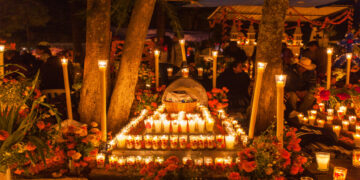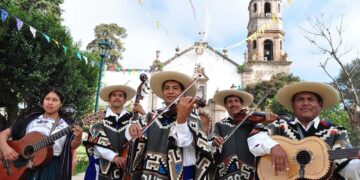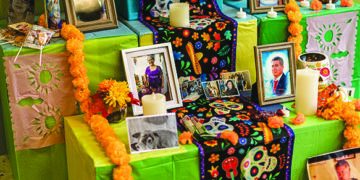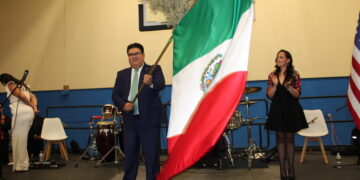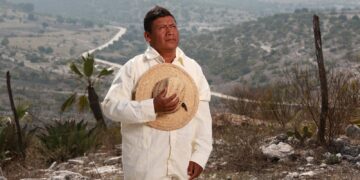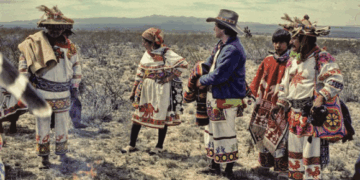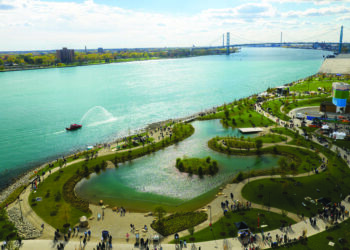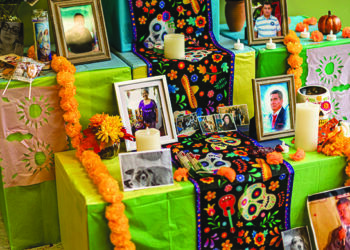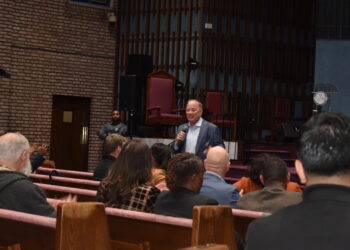Rich, dark soil winds around the front of Grace in Action’s building, peppered with bright green plants stretching out toward the sun. Residents line the walkway to take home small pots of Ohio spiderwort, New England aster, golden Alexander, and more. The anise hyssop, in particular, has a fragrant licorice aroma that sticks to your fingertips.
Pastor John Cummings of Grace in Action – and residents – gathered last Thursday, June 5 to officially cut the ribbon to the rain garden, which had been planted in the fall of 2024. Pastor Cummings passed around plant springs dipped in holy water so the attendees could bless the rain garden.
Grace in Action on Lawndale is the latest activation site in a series of projects that aims to use green infrastructure to cut stormwater costs. Led by the National Wildlife Foundation and partnering with Sierra Club and Friends of the Rouge, the Sacred Ground initiative began in 2018 after a restructuring of Detroit drainage fees was enacted. This restructuring called for a fee for every acre of impervious surface, meaning a church with a parking lot could see an increase in stormwater costs.
“In Detroit you get a discount off of your drainage fee if you have certain kinds of green infrastructure that limits the amount of water that’s going into the stormwater system. Rain gardens are a great way to do that,” Erin Johnson said. She is the Community Organizer for the Sierra Club of Michigan.
Because the native plants chosen for these sites hold more water than grass, they are the best choice for absorbing water runoff. As a bonus, they provide food and habitats for pollinators. Access to nature is also an important benefit. Rain gardens provide green spaces for residents, like the ones tucked in close to the Grace in Action building.
“These rain gardens are a co-benefit type of project that not only attracts pollinators, but also helps with stormwater that is coming off the roofs, the parking lots, any type of non-pervious surface from entering into our combined sewage overflow,” Tiffany Jones, Education and Engagement Manager at the National Wildlife Federation, said at the ribbon cutting of the rain garden. “We also know that these are places of enjoyment for young children to access nature.”
Pastor Cummings was approached with the idea for the Grace in Action rain garden around 2022, Jones said.
“I was excited,” said Pastor Cummings. “It’s just really cool to see people learning about the native plants, how to care for them, help them to flourish, how it benefits the greater ecosystem, the cycle of life.”
Detroit Resident Leticia Gonzalez, whose children attend guitar lessons and programming at Grace in Action, was in attendance on Thursday. She was also part of the community meetings regarding bringing the rain garden to the church.
“[Pastor] John asked for our opinion and the community said it was a good opportunity.”
Sacred Grounds includes 20 Detroit sites such as Detroit Hope, Christ the King, Marygrove, and Gesu. There are 120 sites scattered throughout four cities – Detroit, Cleveland, Toledo, and Grand Rapids. Maintenance efforts and community education are supported as part of the program.
The financial backing comes from the National Fish and Wildlife Foundation.
“This project represents resilience, it represents joy, it represents beauty and so much more. So I’m just pleased and honored to make this a Sacred Ground site,” said Johnson.
To learn more about Nonresidential Drainage Credits and how a rain garden could help offset stormwater costs, visit https://bit.ly/DetroitDrainageGuidelines.
This article and photos were made possible thanks to a generous grant to EL CENTRAL Hispanic News by Press Forward, the national movement to strengthen communities by reinvigorating local news. Learn more at www.pressforward.news.




